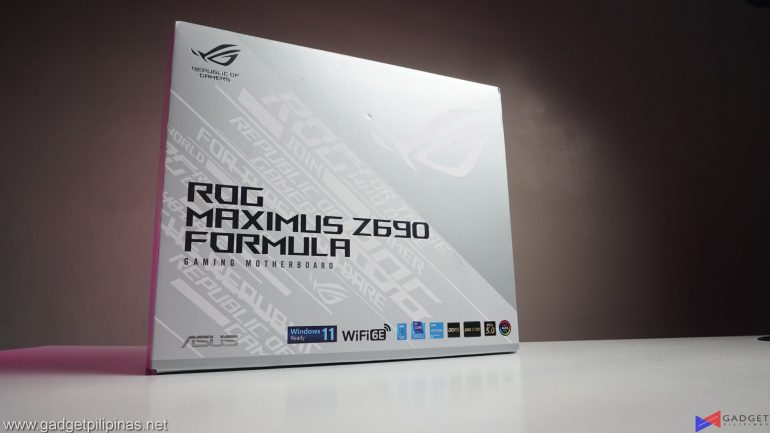Introduction
The ROG Maximus line has been ASUS’ flagship motherboard series for Intel motherboards since the Intel LGA 775 socket. ASUS has slowly been improving the Maximus line with enthusiasts and overclocking-centered features such as robust teamed power stages, CrossChill Water-Cooling compatible VRMs, PCIe RAID cards, and even AI. This year’s iteration of the ROG Maximus line featuring the Intel Z690 chipset sports the most generational upgrades compared to the previous iteration with the debut of PCI-E 5.0 and DDR5 memory. The latest ASUS ROG Maximus Z690 series brings back the Formula model with a new color theme after being skipped on the Maximus Z590 Lineup.
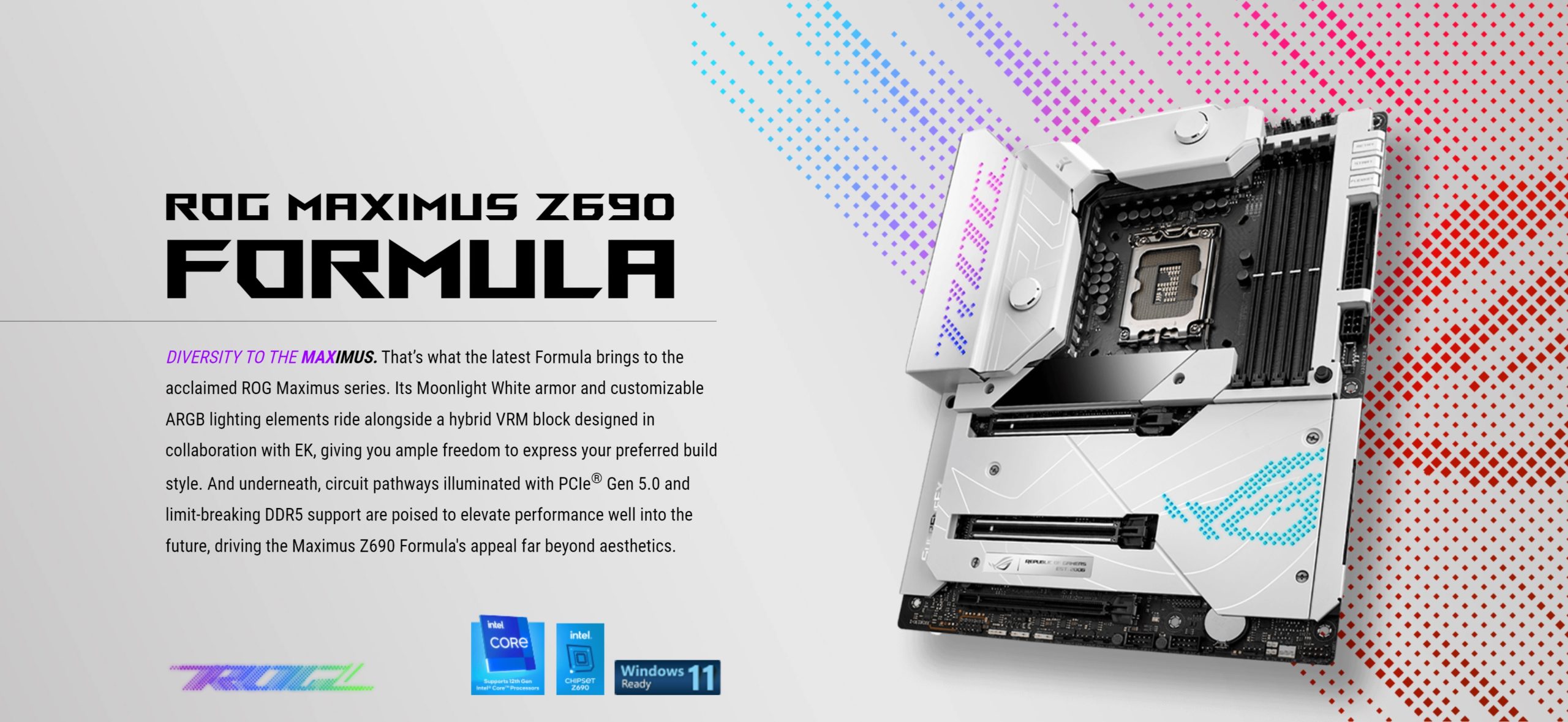
The ASUS ROG Z690 Formula makes a comeback with an all-new Moonlight white look based on the ROG Zephyrus G4 moonlight white. The Moonlight White finish on the ROG Z690 Formula makes it the second cheapest white ROG motherboard priced at Php 41,790 following the ASUS ROG Strix Z690-A Gaming motherboard priced at Php 20,710. After being skipped don’t the Z590 chipset, the ROG Maximus Z690 Formula comes with more features and improvements compared to the Maximus Z690 lineup with Z590 chipset predecessors.
NOTE: A part of this review article is from our ROG Maximus Z690 Formula Unboxing and First Impressions article. Skip to Benchmark Setup and Methodology section if you’ve already read our previous article.
Intel Z690 Chipset
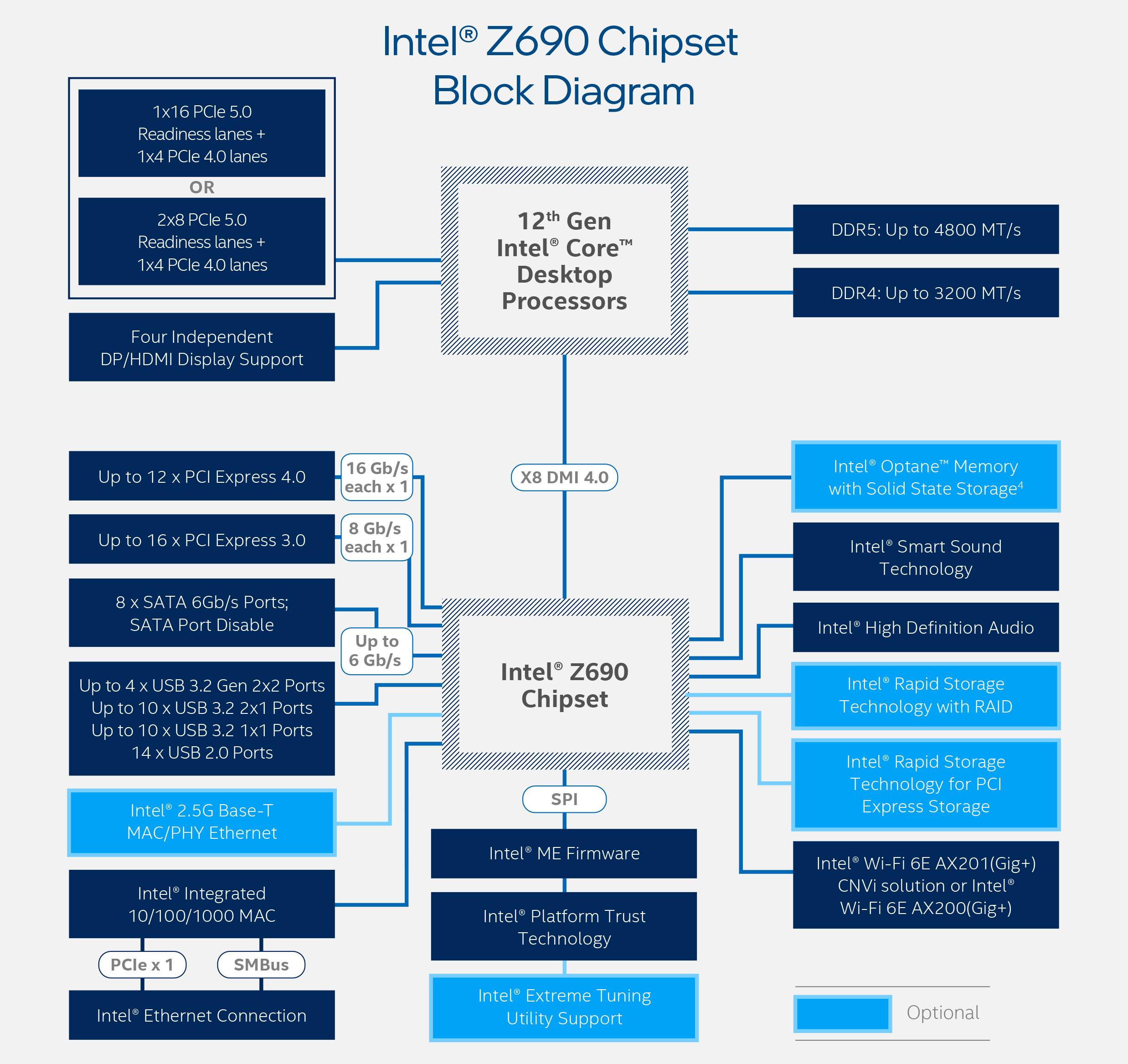 A new generation of processors means a new chipset to support it as well. Alongside the 12th Generation Intel Core processors comes Intel’s Z690 Chipset sporting robust bandwidth offering support for both the latest DDR5 memory and PCI-E 5.0 Standard. Z690 Chipset is built to maximize responsiveness, increased DMI throughput, and increased bandwidth. The chipset also supported integrated Intel WiFi 6E technology for more reliable connections across new 6 GHz WiFi channels. With the Z690 Chipset, Intel 12th Gen Core desktop processors can achieve enhanced overclocking to run the CPUs and memory above its technical specification resulting in higher performance across the board.
A new generation of processors means a new chipset to support it as well. Alongside the 12th Generation Intel Core processors comes Intel’s Z690 Chipset sporting robust bandwidth offering support for both the latest DDR5 memory and PCI-E 5.0 Standard. Z690 Chipset is built to maximize responsiveness, increased DMI throughput, and increased bandwidth. The chipset also supported integrated Intel WiFi 6E technology for more reliable connections across new 6 GHz WiFi channels. With the Z690 Chipset, Intel 12th Gen Core desktop processors can achieve enhanced overclocking to run the CPUs and memory above its technical specification resulting in higher performance across the board.
ASUS ROG Maximus Z690 Formula Specs
| Socket | LGA 1700 |
| Chipset | Z690 |
| Form Factor | ATX |
| Voltage Regulator | 21 Phase (20+1 90A MOSFETs for Vcore) |
| Video Ports | (1) HDMI (v2.1) |
| (2) Thunderbolt 4 USB Type-C | |
| USB Ports | (2) Thunderbolt 4, Type-C (40 Gbps, up to 5V/12A 60W charging support) |
| (7) USB 3.2 Gen 2, 6x Type-A, 1x Type-C (10 Gbps) | |
| (2) USB 2.0 (480 Mbps) | |
| Network Jacks | (1) 2.5 GbE |
| Audio Jacks | (5) Analog + SPDIF |
| Legacy Ports/Jacks | ✗ |
| Other Ports/Jack | ✗ |
| PCIe x16 | (2) v5.0 (x16, x8/x8) |
| (1) v4.0 (x4) | |
| PCIe x8 | ✗ |
| PCIe x4 | ✗ |
| PCIe x1 | ✗ |
| CrossFire/SLI | ?? |
| DIMM slots | (4) DDR5 6400+(OC), 128GB Capacity |
| M.2 slots | (1) PCIe 4.0 x4 (64 Gbps) / PCIe (up to 110mm) |
| (1) PCIe 3.0 x4 (32 Gbps) / PCIe (up to 80mm) | |
| (1) PCIe 4.0 x4 (64 Gbps) / PCIe + SATA (up to 80mm) | |
| From ROG Hyper M.2 Card | |
| (1) PCIe 5.0 x4 (128 Gbps) / PCIe (up to 110mm) | |
| (1) PCIe 4.0 x4 (64 Gbps) / PCIe (up to 110mm) | |
| Or | |
| (2) PCIe 4.0 x4 (64 Gbps) / PCIe (up to 110mm) | |
| * Supports NVMe RAID 0/1/5 | |
| U.2 Ports | ✗ |
| SATA Ports | (6) SATA3 6 Gbps (Supports RAID0/1/5/10) |
| USB Headers | (1) USB v3.2 Gen 2×2, Type-C (20 Gbps) |
| (2) USB v3.2 Gen 1 (5 Gbps) | |
| (2) USB v2.0 (480 Mbps) | |
| Fan/Pump Headers | (8) 4-Pin (CPU, CPU OPT, AIO, Chassis, W_PUMP) |
| RGB Headers | (3) aRGB (3-pin) |
| (1) AURA RGB (4-pin) | |
| Diagnostics Panel | 2-character debug LED, Post Status Checker (4 LEDs) |
| Internal Button/Switch | Retry, Start, and Flex Key buttons |
| SATA Controllers | ✗ |
| Ethernet Controller(s) | Intel I225-V (2.5 Gbps) |
| Wi-Fi / Bluetooth | Intel AX201 Wi-Fi 6E (2×2 ax, 2.4/5/6 GHz, 160 MHz, BT 5.2) |
| USB Controllers | ✗ |
| HD Audio Codec | RROG Supreme FX (Realtek ALC4082) |
| DDL/DTS Connect | ✗ / DTS Sound Unbound |
| Warranty | 3 Years |
ASUS ROG Maximus Z690 Formula Unboxing and First Impressions
- ASUS ROG Maximus Z690 Formula Review 002
- ASUS ROG Maximus Z690 Formula Review 002
- ASUS ROG Maximus Z690 Formula Review 007
- ASUS ROG Maximus Z690 Formula Review 007
The ROG Maximus Z690 Formula comes in a packaging design similar to the ROG Zephyrus G14 Moonlight White gaming notebook. With a new platform featuring DDR5 and PCI-E Gen 5, ASUS slapped lots of badges on the lower right part of the box. Like the previous ROG motherboards, the Z690 Formula’s key features and specs are highlighted at the backside of the packaging.
ACCESSORIES LIST
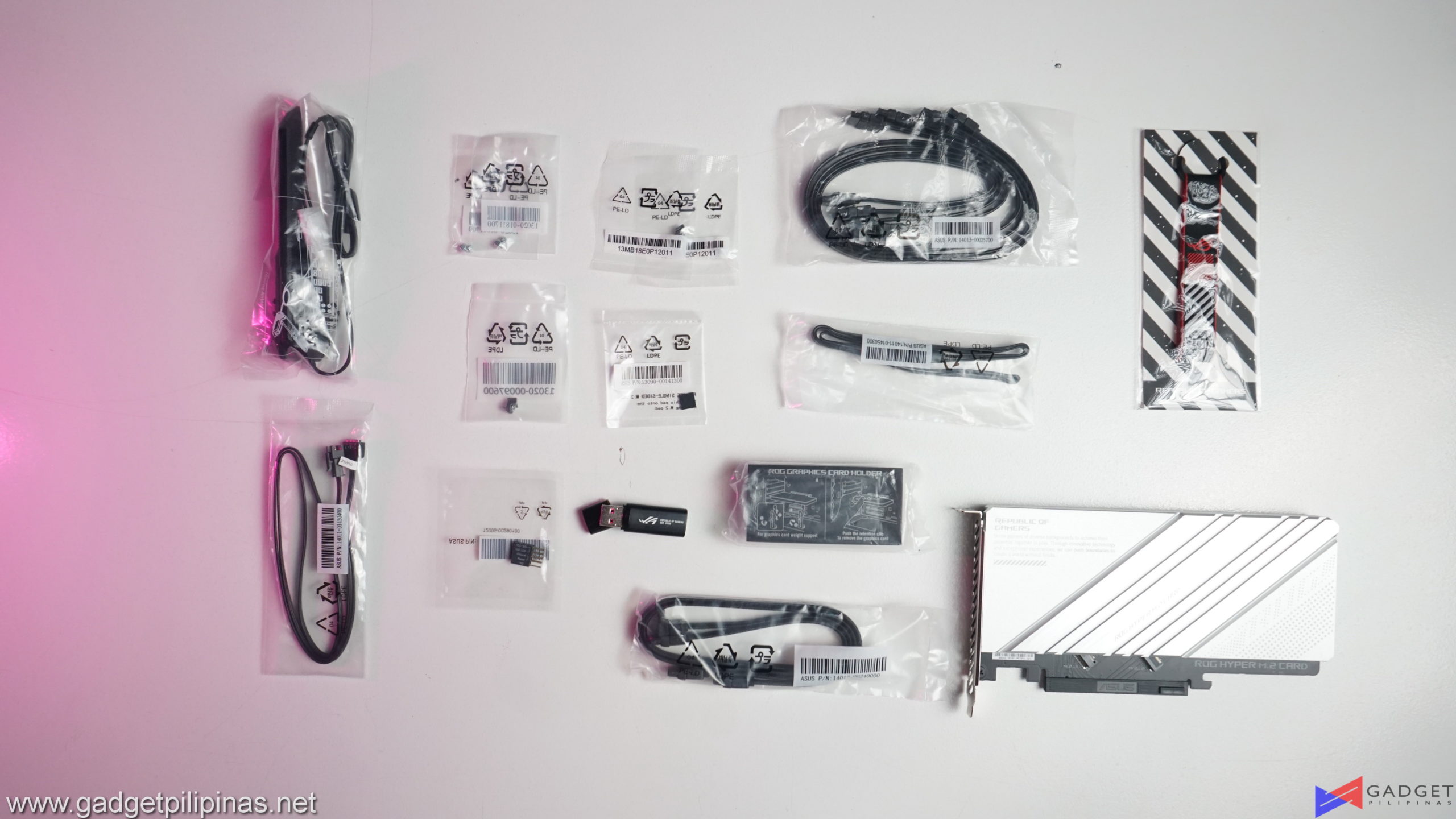 USB Flashdrive
USB Flashdrive- 4x SATA 6Gb/s cables
- 1x ROG Graphics Card Holder
- 4x M.2 SSD screw package
- 1x ROG Hyper M.2 Card
- 1x ROG Keychain
- 1x Wi-Fi 6E moving antenna
- 1x Thermistor cable
- 1x 2-in-1 Rubber pad
- 1x Q-connector
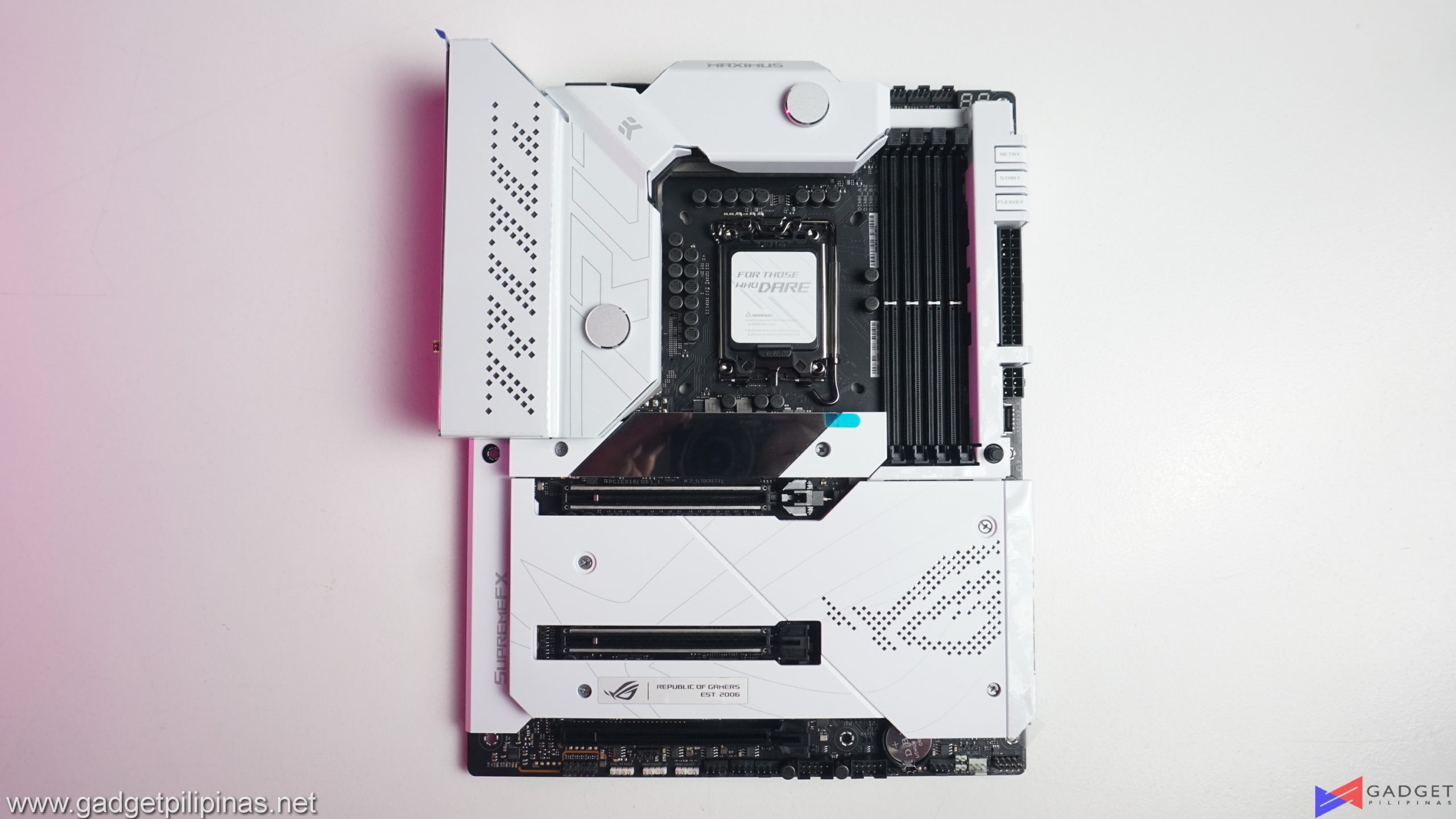 ASUS decided to give the Maximus Z690 Formula a white treatment as its heatsinks and heat spreaders now come in a moonlight white finish. The ASUS ROG Maximus Z690 Formula is the first Maximus-line motherboard to have a white design not a special-edition motherboard like the now-last gen Maximus Extreme Glacial that’s arguably more gray than white.
ASUS decided to give the Maximus Z690 Formula a white treatment as its heatsinks and heat spreaders now come in a moonlight white finish. The ASUS ROG Maximus Z690 Formula is the first Maximus-line motherboard to have a white design not a special-edition motherboard like the now-last gen Maximus Extreme Glacial that’s arguably more gray than white.
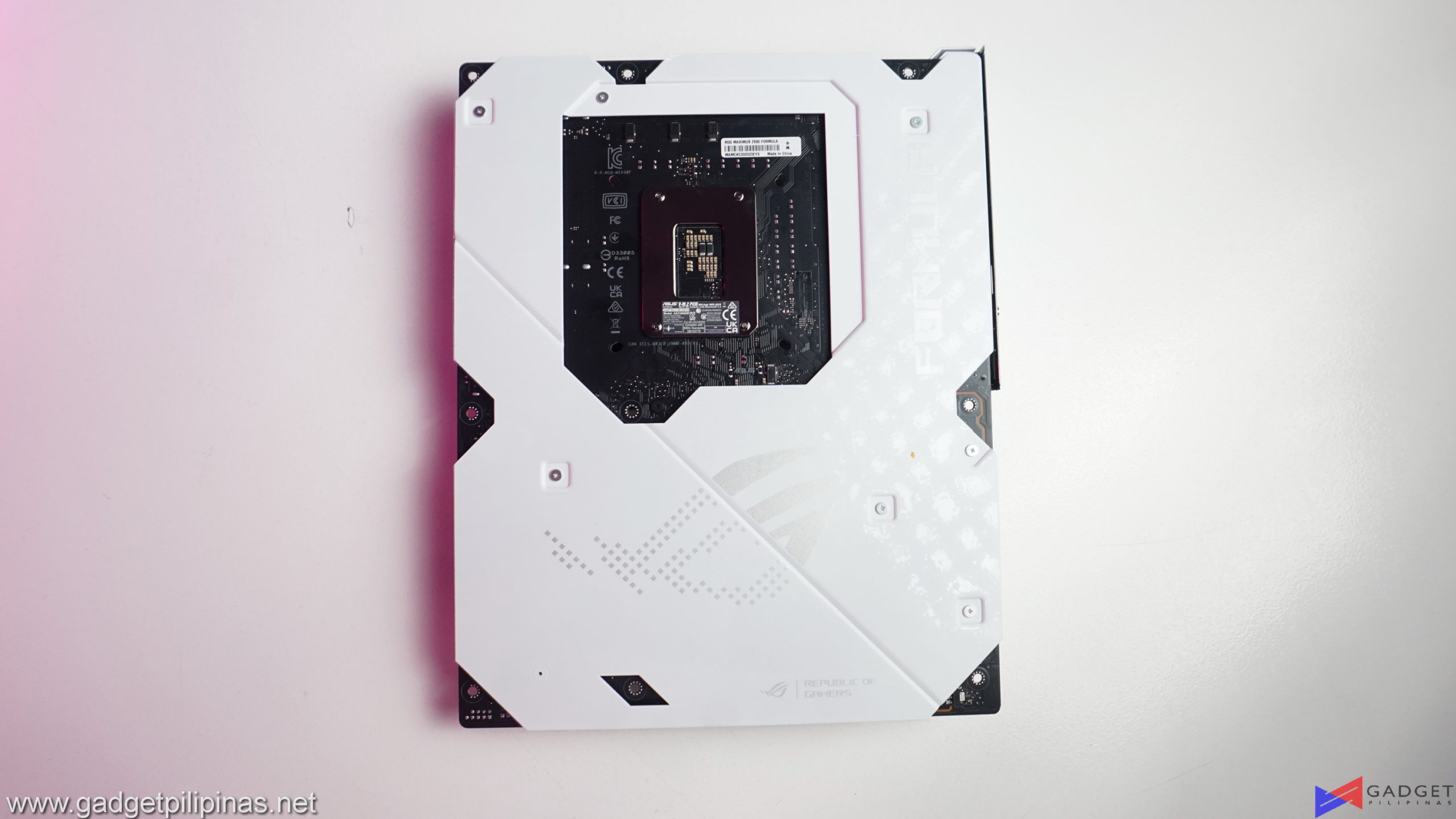 ASUS’ dedication to make the Maximus Z690 Formula a clean all-white aesthetic is commendable as the back armor plate is also colored in white with a very minimalist ROG logo design as opposed to the previous boards having the signature ROG Cybertext design.
ASUS’ dedication to make the Maximus Z690 Formula a clean all-white aesthetic is commendable as the back armor plate is also colored in white with a very minimalist ROG logo design as opposed to the previous boards having the signature ROG Cybertext design.
- ASUS ROG Maximus Z690 Formula Review 080
- ASUS ROG Maximus Z690 Formula Review 080
- ASUS ROG Maximus Z690 Formula Review 040
- ASUS ROG Maximus Z690 Formula Review 040
Two 8pin EPS 12V connectors are on the ROG Maximus Z690 Formula to accommodate the latest Intel 12th Generation Core series processors. ASUS went for the proven and tested ProCool II power connectors found on the ROG Z590 motherboards for a reinforced contact between the solid-core pins and PSU cables.
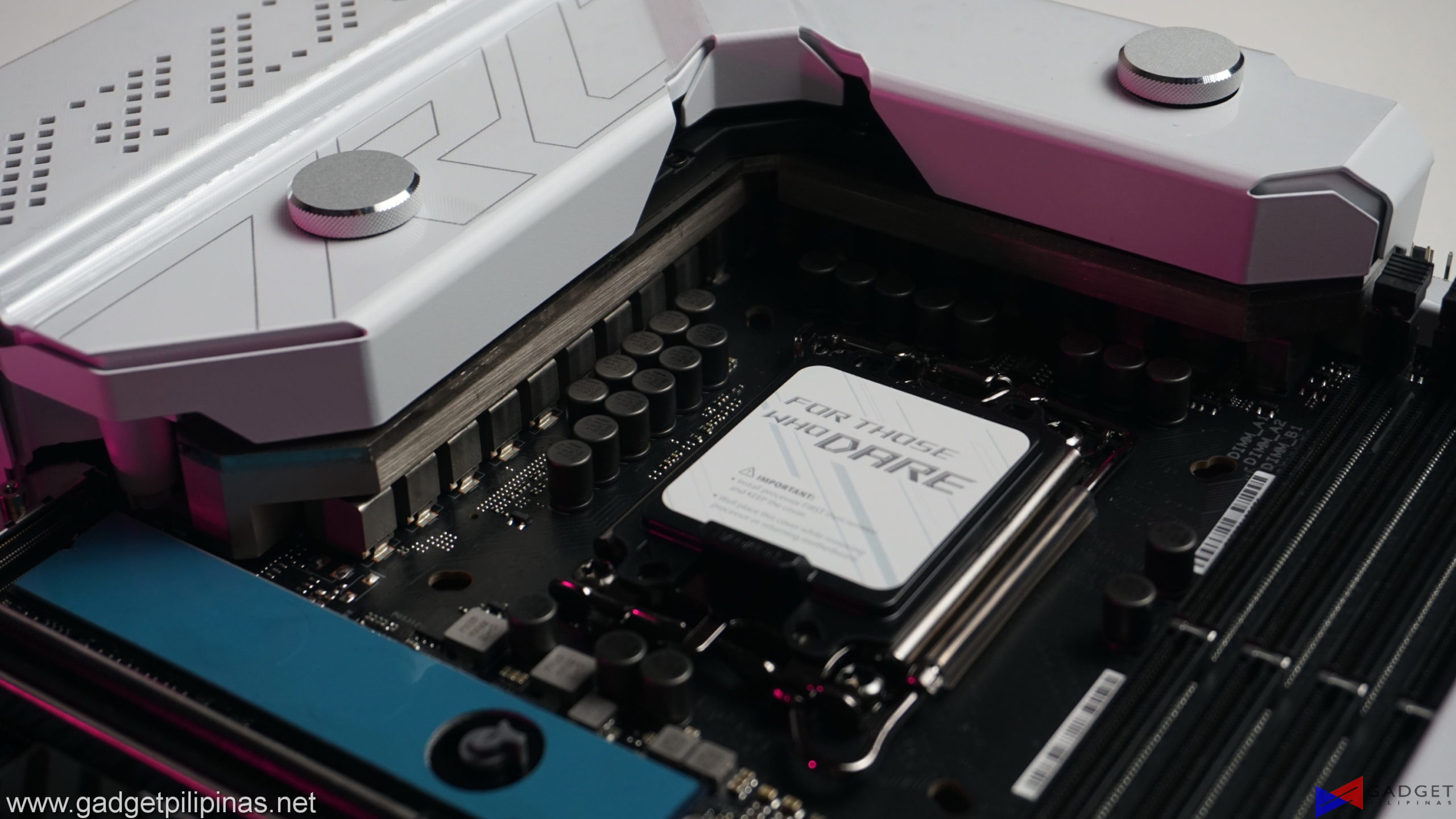 ASUS has upped the VRM configuration on all of its motherboards from entry-level to high-end for better performance and stability on the upcoming Intel 12th Gen Core series processors. The ROG Maximus Z690 Formula has a 20+1 Power Stages that are in a teamed configuration for a total power delivery output of 105A.
ASUS has upped the VRM configuration on all of its motherboards from entry-level to high-end for better performance and stability on the upcoming Intel 12th Gen Core series processors. The ROG Maximus Z690 Formula has a 20+1 Power Stages that are in a teamed configuration for a total power delivery output of 105A.
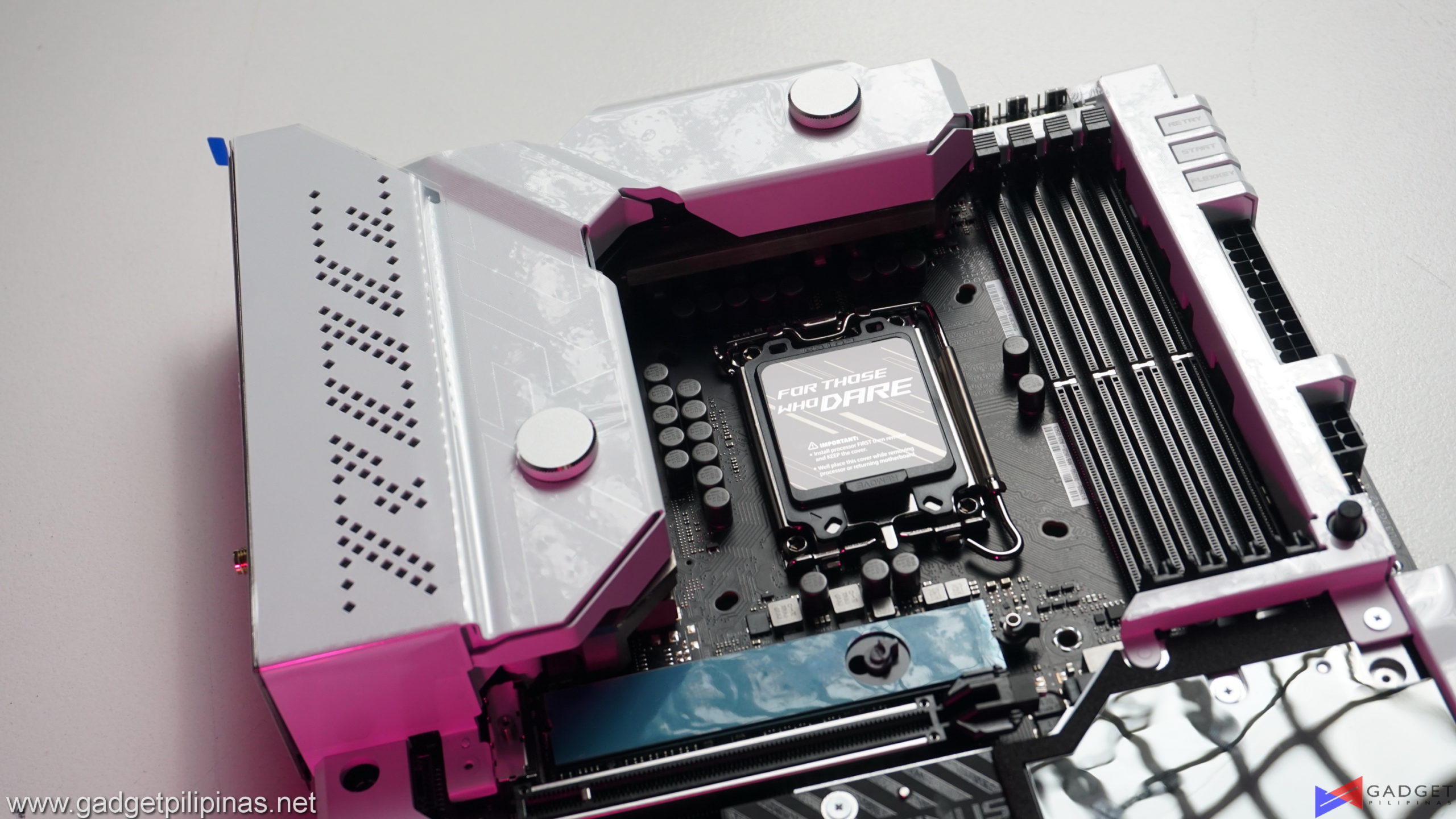 Built-in waterblocks on the VRM heatsink remain a distinctive feature of the Formula family. ASUS has teamed up with EK water blocks to equip the ASUS ROG Maximus Z690 Formula with the latest CrossChill EK III VRM water block allowing the Z690 Formula to handle the latest Intel 12th Gen Processors, even the flagship Intel Core i9 12900K.
Built-in waterblocks on the VRM heatsink remain a distinctive feature of the Formula family. ASUS has teamed up with EK water blocks to equip the ASUS ROG Maximus Z690 Formula with the latest CrossChill EK III VRM water block allowing the Z690 Formula to handle the latest Intel 12th Gen Processors, even the flagship Intel Core i9 12900K.
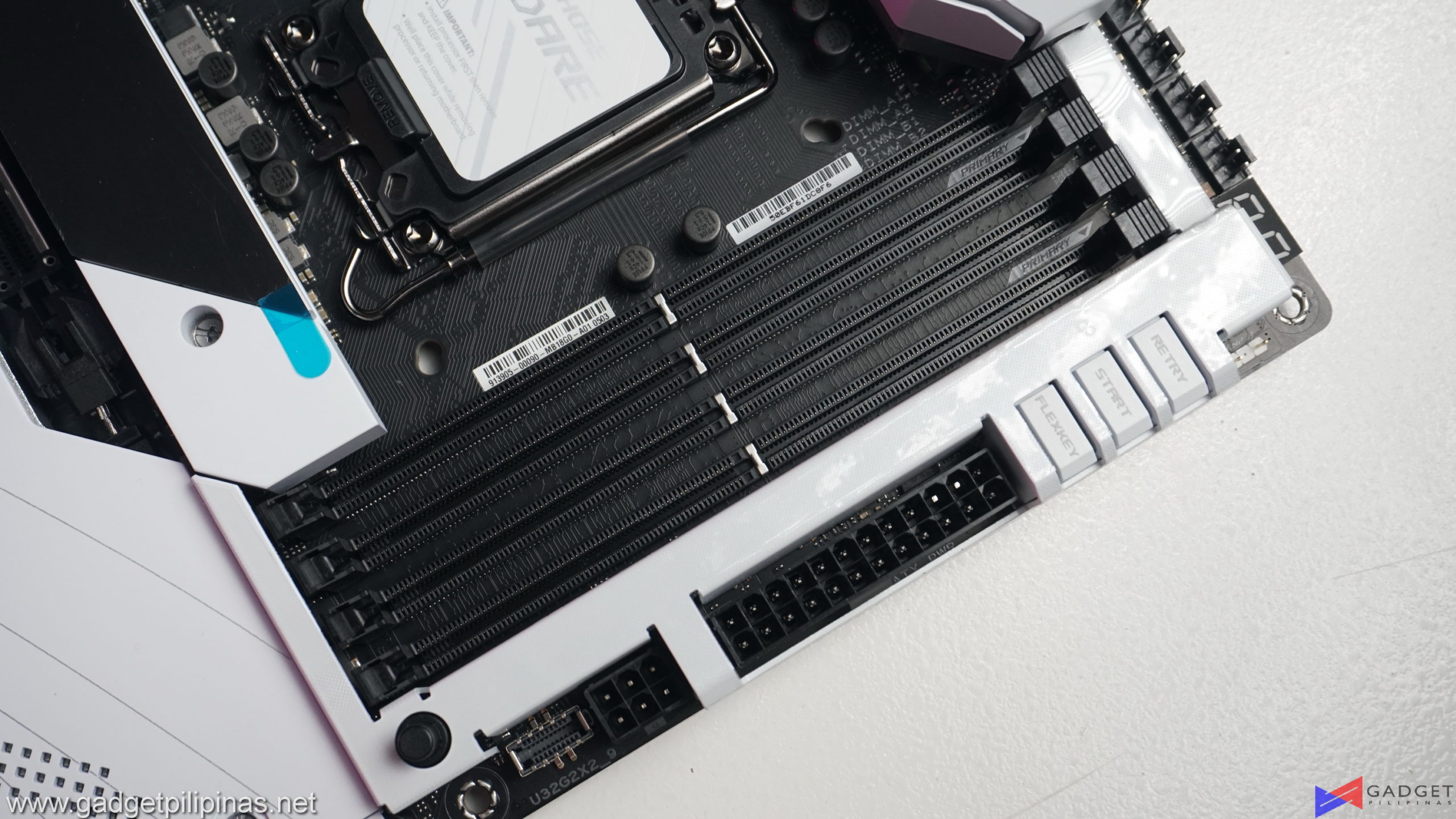 Like the Skylake platform, motherboards manufacturers have the choice to select which memory generation to support as the market transitions to the new JEDEC DDR5 standard. The ROG Maximus Z690 family supports only DDR5 in all of the four DIMM slots available. Memory support on the ROG Maximus Z690 Formula is capped at a total of 128GBs with a maximum DDR5 frequency of 6,400Mhz. Like the previous ROG Z590 motherboards, the ROG Maximus Z690 Formula also uses a daisy chain trace design instead of a T-Tpology layout allowing the motherboard to achieve a higher peak frequency and enhanced memory compatibility, performance, and overclocking margin per DIMM.
Like the Skylake platform, motherboards manufacturers have the choice to select which memory generation to support as the market transitions to the new JEDEC DDR5 standard. The ROG Maximus Z690 family supports only DDR5 in all of the four DIMM slots available. Memory support on the ROG Maximus Z690 Formula is capped at a total of 128GBs with a maximum DDR5 frequency of 6,400Mhz. Like the previous ROG Z590 motherboards, the ROG Maximus Z690 Formula also uses a daisy chain trace design instead of a T-Tpology layout allowing the motherboard to achieve a higher peak frequency and enhanced memory compatibility, performance, and overclocking margin per DIMM.
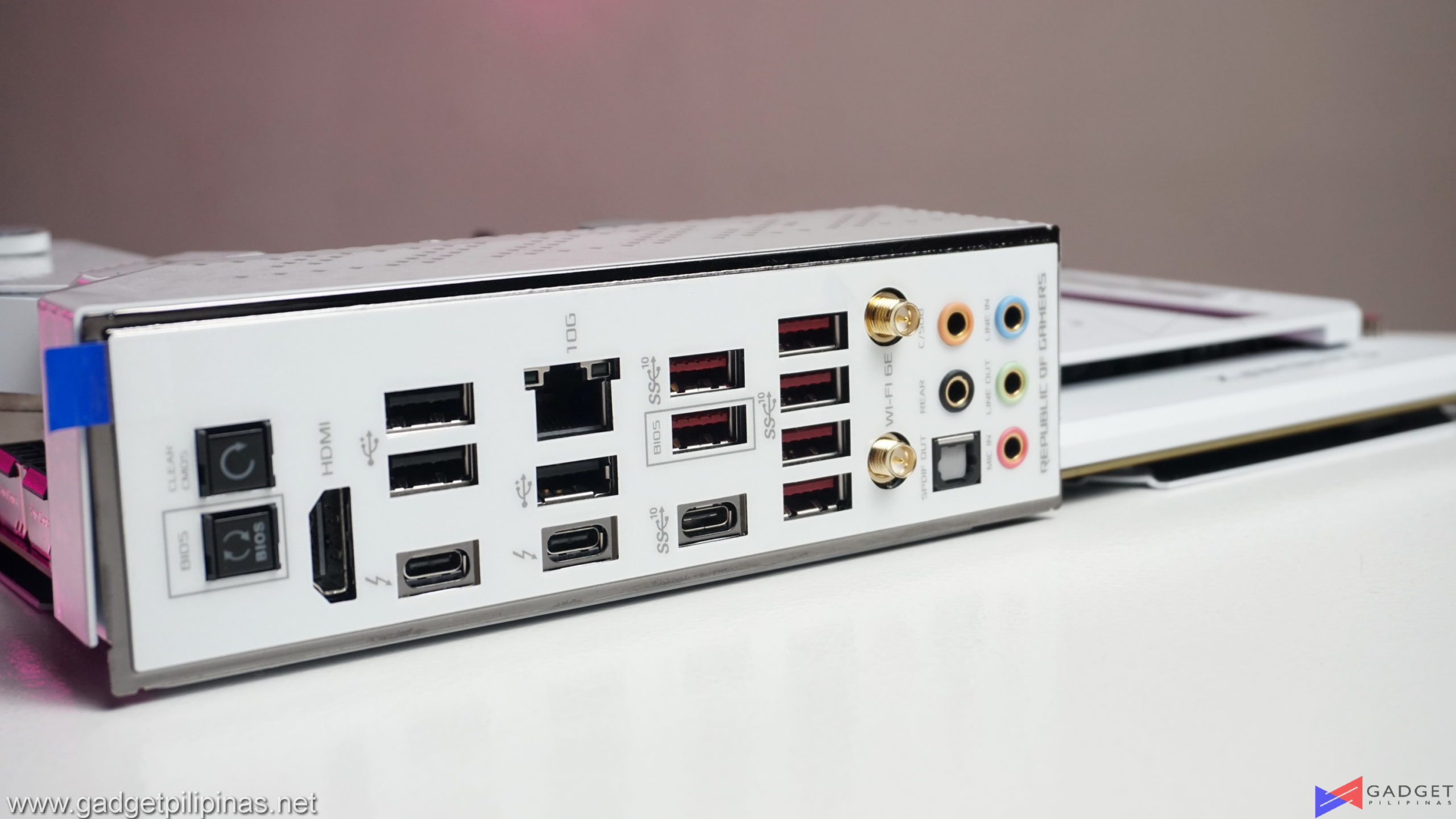 A new chipset always comes with better connectivity with the Intel Z690 Chipset officially supporting up to 4 USB 3.2 Gen 2×2 ports and up to 10 USB 3.2 Gen 2. Connectivity on the ROG Maximus Z690 Formula is robust with seven USB ports including one USB type-c port supporting USB 3.2 Gen 2 and three USB 2.0 ports. The remaining USB Type-C ports support Thunderbolt 4 for 40Gbps transfer speeds as well as 8K video support via Alderlake’s integrated graphics.
A new chipset always comes with better connectivity with the Intel Z690 Chipset officially supporting up to 4 USB 3.2 Gen 2×2 ports and up to 10 USB 3.2 Gen 2. Connectivity on the ROG Maximus Z690 Formula is robust with seven USB ports including one USB type-c port supporting USB 3.2 Gen 2 and three USB 2.0 ports. The remaining USB Type-C ports support Thunderbolt 4 for 40Gbps transfer speeds as well as 8K video support via Alderlake’s integrated graphics.
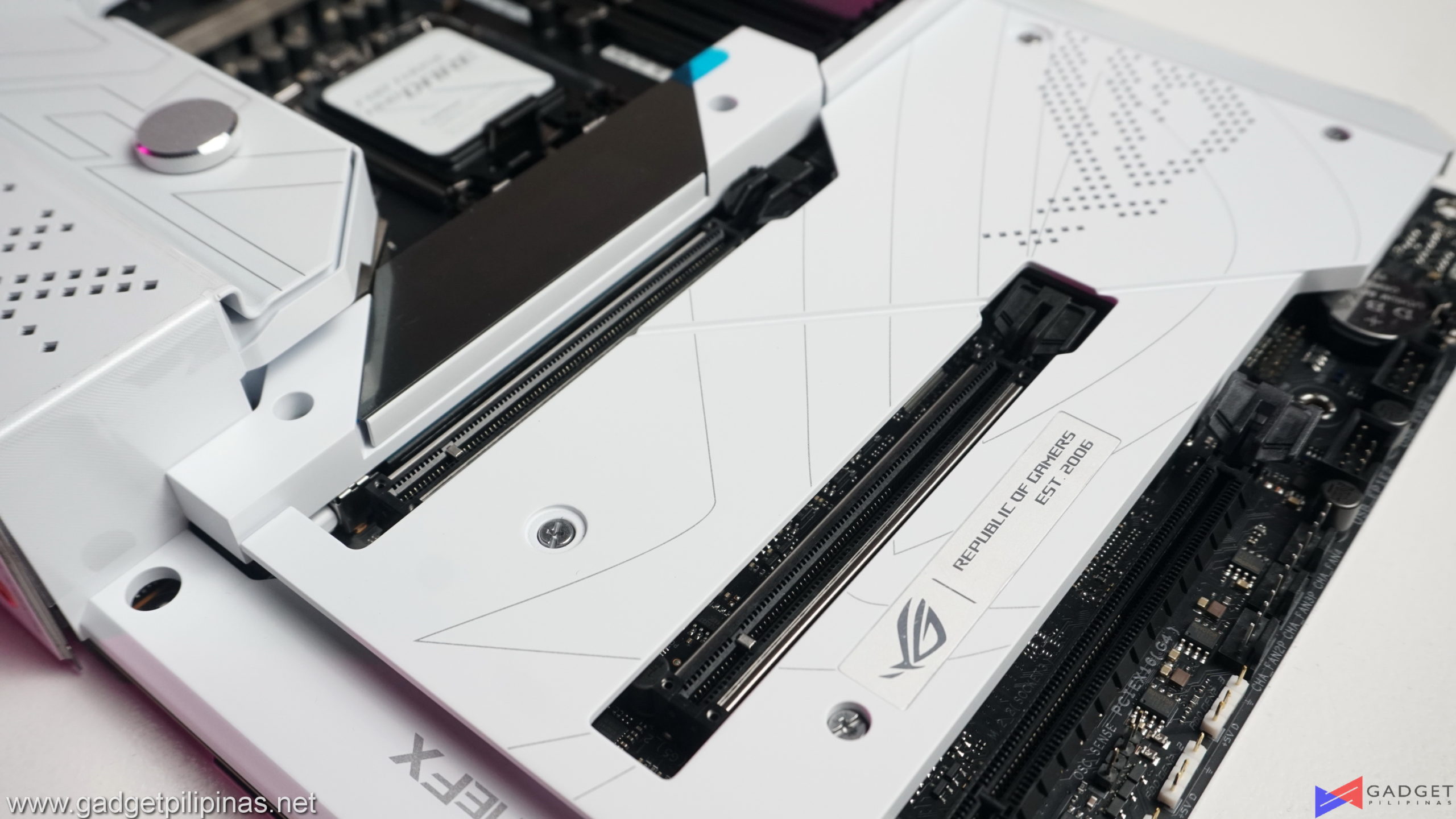 ASUS opted for a single block solution for its M.2 heatsink instead of the modular, two-piece M.2 heatsinks shrouds found on last generation Z590 and Z490 motherboards. The whole bottom armor acts as a heatsink for the M.2 slots as well as the Z690 chipset. Both PCIe x16 slots support the latest PCIe 5.0 which has double the bandwidth of PCIe Gen 4 with a max bandwidth of 63.02 GB/s.
ASUS opted for a single block solution for its M.2 heatsink instead of the modular, two-piece M.2 heatsinks shrouds found on last generation Z590 and Z490 motherboards. The whole bottom armor acts as a heatsink for the M.2 slots as well as the Z690 chipset. Both PCIe x16 slots support the latest PCIe 5.0 which has double the bandwidth of PCIe Gen 4 with a max bandwidth of 63.02 GB/s.
- ASUS ROG Maximus Z690 Formula Review 101
- ASUS ROG Maximus Z690 Formula Review 101
- ASUS ROG Maximus Z690 Formula Review 102
- ASUS ROG Maximus Z690 Formula Review 102
A total of five M.2 SSDs can be installed on the ASUS ROG Maximus Z690 Formula. Three M.2 slots are available on the motherboard itself while the last two M.2 slots can be accessed via the ROG Hyper M.2 card which we’ll talk about later in the article.
- ASUS ROG Maximus Z690 Formula Review 123
- ASUS ROG Maximus Z690 Formula Review 123
- ASUS ROG Maximus Z690 Formula Review 124
- ASUS ROG Maximus Z690 Formula Review 124
As mentioned earlier, the whole bottom armor acts as a heatsink for both the M.2 slots and the Z590 chipset itself. The topmost m.2 slot has a separate heatsink as it’s positioned above the first PCI-E x16 slot. The heatsink also has an LED panel for aesthetics.
LGA1200 Cooler Mounting Support
- ASUS ROG Maximus Z690 Formula Review 068
- ASUS ROG Maximus Z690 Formula Review 068
- ASUS ROG Maximus Z690 Formula Review 072
- ASUS ROG Maximus Z690 Formula Review 072
A new LGA socket means a new mounting bracket for coolers which is the worst part of socket upgrade especially for consumers sporting old or discontinued coolers. New coolers supporting the latest brackets take a while to ship and that’s if you find a cooler that could fit your personal preference. Fortunately for ASUS Z690 motherboard bios, all motherboards have LGA 1200 cooler cutouts so that users have the option to use their old cooler without the need for a new mounting bracket or a new cooler. However, ASUS advises using LGA 1700 compatible coolers and brackets as Alderlake CPUs are relatively lower and the small height difference may cause compatibility issues for some coolers.
Q-LATCH
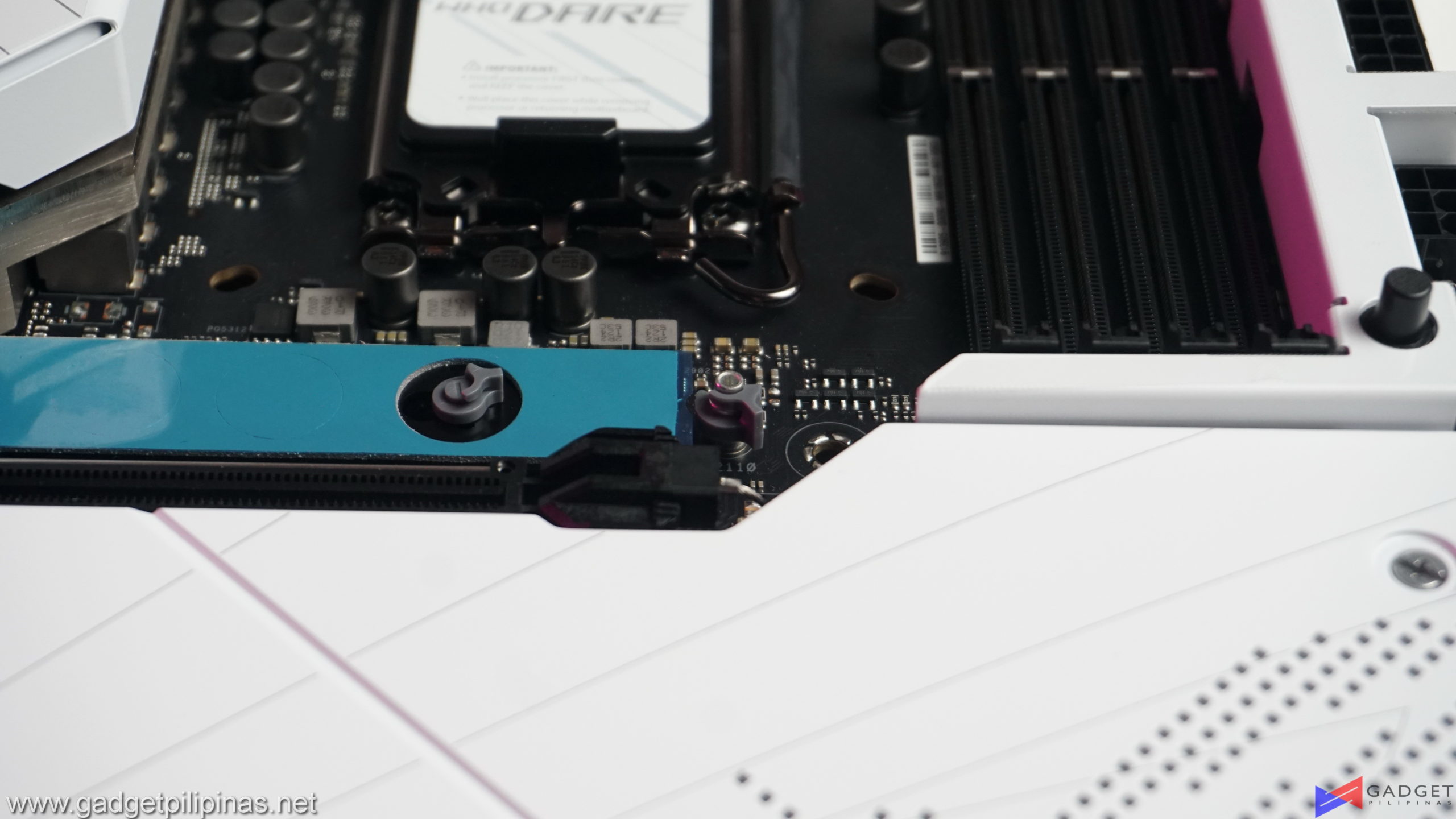 ASUS implemented Q-Latch support for all of the M.2 slots on the ROG Maximus Z690 Formula removing the need for M.2 screws that are relatively annoying to install. The Q-Latch feature debuted on select ROG, TUF, and Prime Z590 motherboards. Q-Latch is installed Z690 in every ASUS Z690 chipset motherboards except for the ASUS Prime -P series motherboards.
ASUS implemented Q-Latch support for all of the M.2 slots on the ROG Maximus Z690 Formula removing the need for M.2 screws that are relatively annoying to install. The Q-Latch feature debuted on select ROG, TUF, and Prime Z590 motherboards. Q-Latch is installed Z690 in every ASUS Z690 chipset motherboards except for the ASUS Prime -P series motherboards.
Q-RELEASE
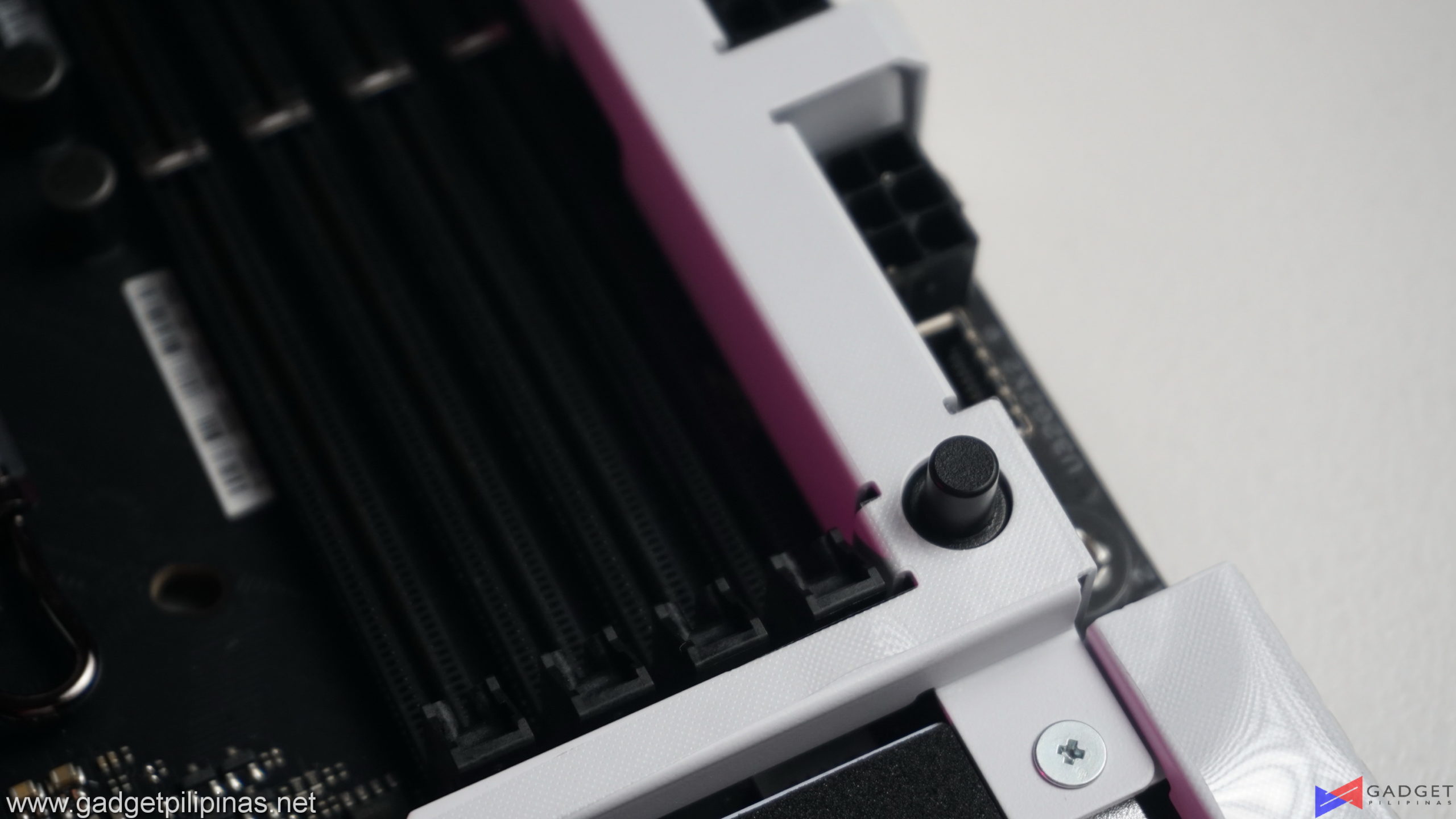 Q-Release is a new feature only found on top-end ROG Strix Z690 motherboards and the whole ROG Maximus lineup. Q-Release is a convenient way of removing your graphics card without having to go through the ordeal of sticking your fingers to find the PCIe lock. Users only need to push the button found between the DIMM slots and chipset heatsink to instantly unlock the top-most PCIe x16 slot.
Q-Release is a new feature only found on top-end ROG Strix Z690 motherboards and the whole ROG Maximus lineup. Q-Release is a convenient way of removing your graphics card without having to go through the ordeal of sticking your fingers to find the PCIe lock. Users only need to push the button found between the DIMM slots and chipset heatsink to instantly unlock the top-most PCIe x16 slot.
ROG HYPER M.2 CARD
- ASUS ROG Maximus Z690 Formula Review 186
- ASUS ROG Maximus Z690 Formula Review 186
- ASUS ROG Maximus Z690 Formula Review 188
- ASUS ROG Maximus Z690 Formula Review 188
To maximize the Z690’s superb connectivity, select ROG Maximus and ROG Strix gaming motherboards comes with an ROG Hyper M.2 card for expanded storage. The M.2 that comes with the ASUS ROG Maximus Z690 Formula can be configured with either a single PCIe 5.0 or Dual PCIe 4.0 SSDs.
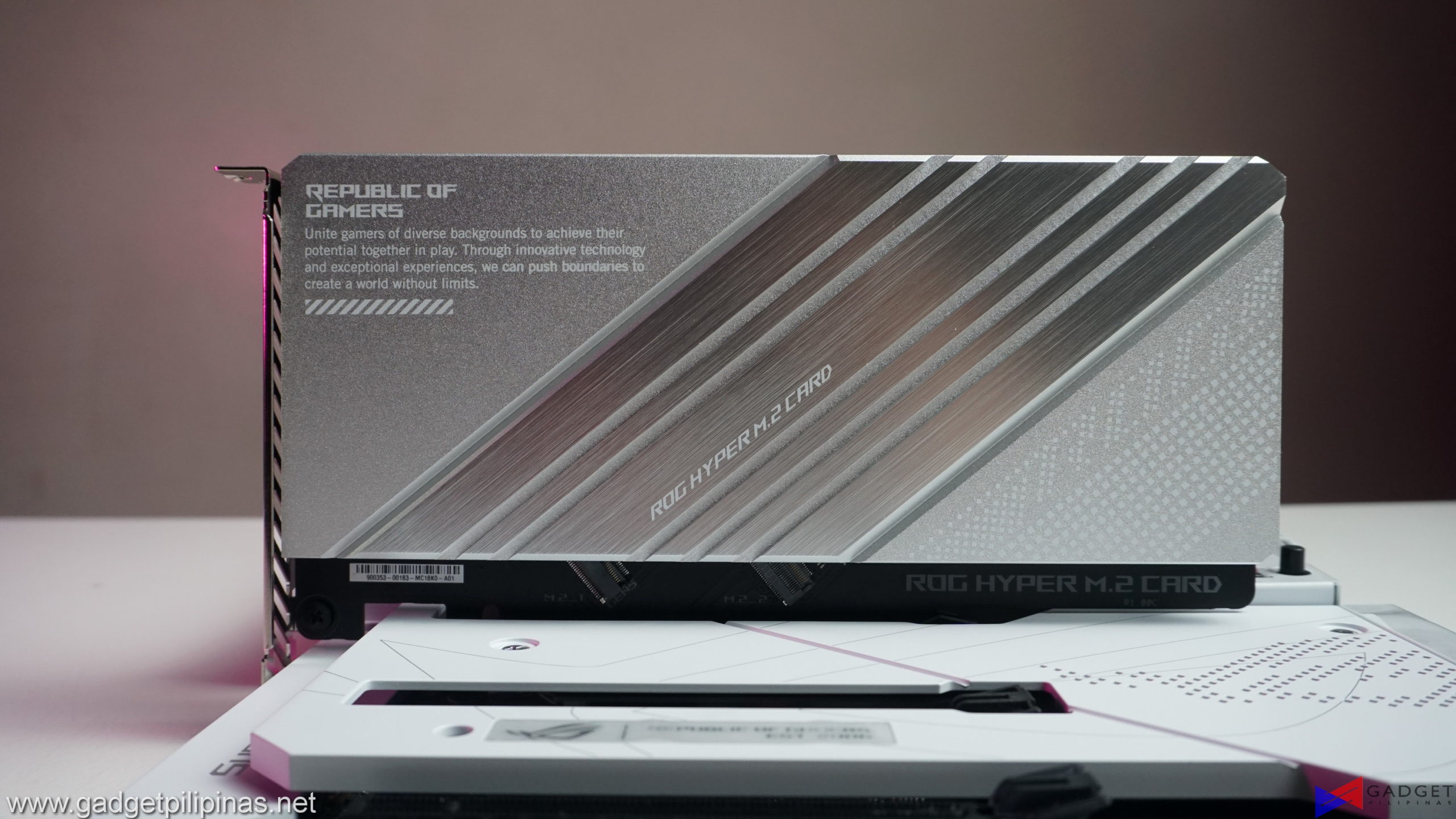 The ROG Hyper M.2 card on the Maximus Z690 Formula follows the general Moonlight White theme of the motherboard. Users need to manually select their desired Hyper M.2 card configuration in the UEFI BIOS.
The ROG Hyper M.2 card on the Maximus Z690 Formula follows the general Moonlight White theme of the motherboard. Users need to manually select their desired Hyper M.2 card configuration in the UEFI BIOS.
Benchmark Setup and Methodology
Gadget Pilipinas’ testing philosophy is to provide detail-oriented results as accurately as possible that our readers can replicate our tests given that these conditions are met. Different benchmarking apps and sequences are used depending on the component or device being tested.
| ASUS ROG Maximus Z690 Formula Review Test Bench Specs | |||
| CPU | Intel Core i9 12900k | ||
| COOLER | ASUS ROG RYUJIN II 360mm V2 – Noctua NT-H2 Thermal Paste | ||
| MOTHERBOARD | ASUS ROG Maximus Z690 Formula Motherboard | ASUS ROG Strix Z690-E Gaming Motherboard | ASUS TUF Gaming Z690-PLUS WIFI DDR4 |
| MEMORY | Kingston Fury Beast 32GB(2x16GB) 5200 Mhz DDR5 | ||
| GPU | Inno3D RTX 3080 Ti iChill X4 | ||
| STORAGE | WD SN850 2TB NVMe SSD | ||
| POWERSUPPLY | FSP Hydro PTM Pro 1200W 80+ Platinum Power Supply | ||
| OPERATING SYSTEM | Windows 11 Pro Build 22000 | ||
| DISPLAY | Lenovo Legion Y27Q Gaming Monitor | ||
We use CapFrameX 1.6.5 as our primary FPS capture and analysis tool for all our gaming benchmarks. The latest build versions of Windows 11 and WHQL certified drivers are used for our benchmarks. Readings such as temperatures and power draw are recorded using HWINFO64, and other relevant software for cross-checking.
ASUS ROG Maximus Z690 Formula Synthetic Benchmarks
SuperPI 32M
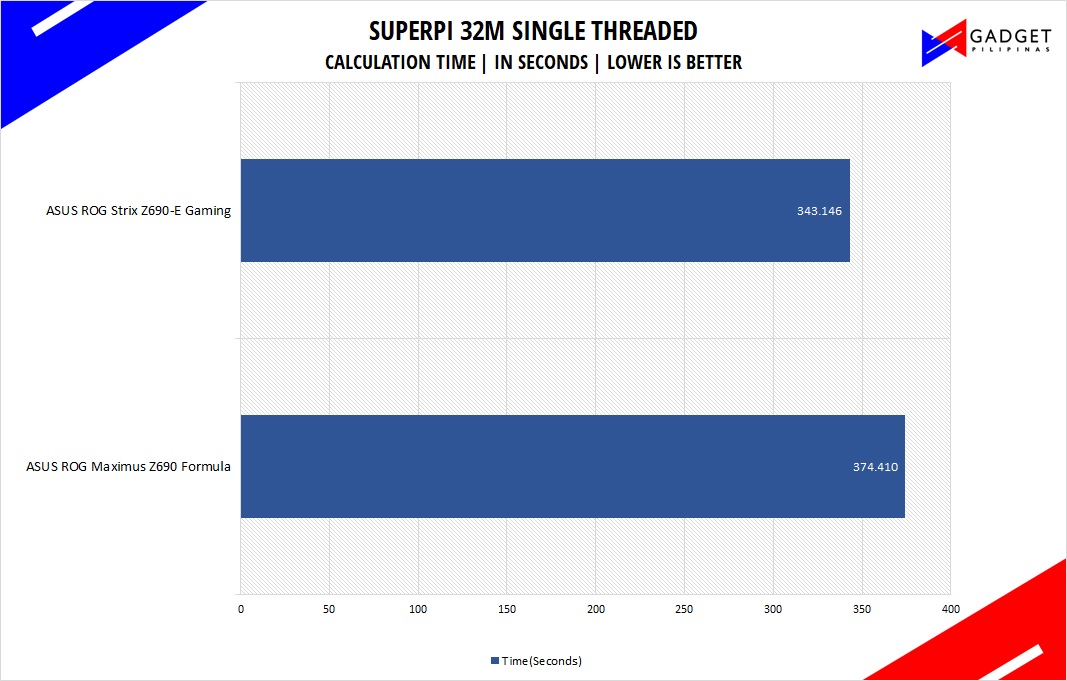 SuperPI is a single-threaded benchmark application that lets the CPU calculate Pi(π) to the nth digit. In this benchmark, we selected the Pi calculation to 32M, the highest available in the software
SuperPI is a single-threaded benchmark application that lets the CPU calculate Pi(π) to the nth digit. In this benchmark, we selected the Pi calculation to 32M, the highest available in the software
wPrime 1024M
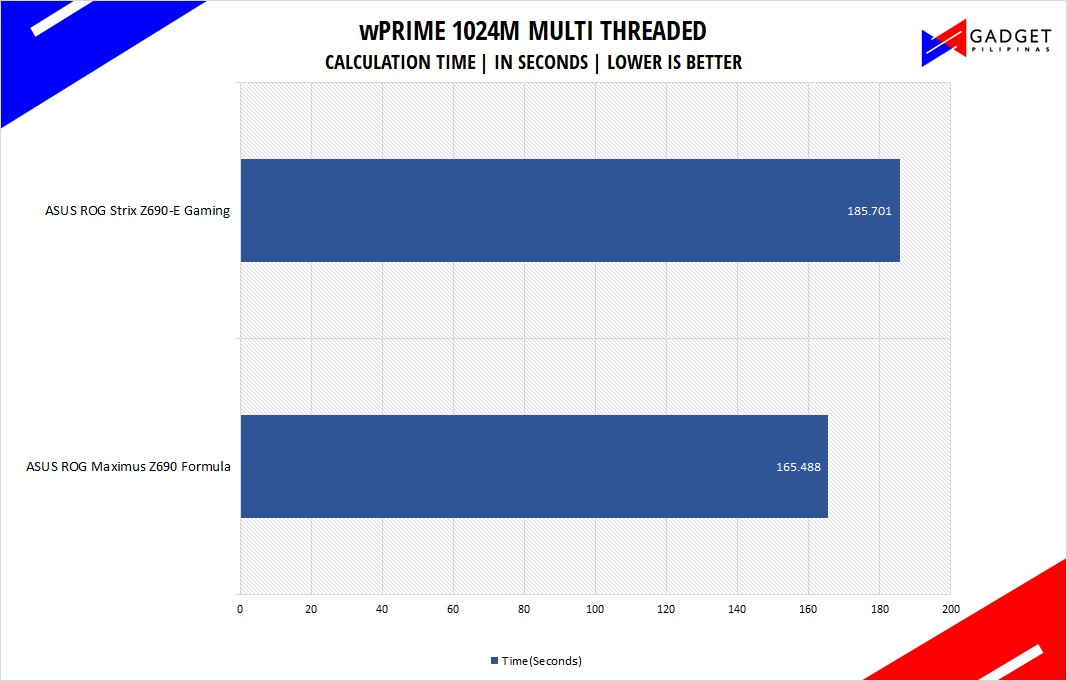 wPrime is a benchmark tool similar to SuperPI, but the former takes on finding prime numbers using Newton’s Method. The benchmark is set to calculate 1024 million prime numbers, and the performance is measured according to calculation time.
wPrime is a benchmark tool similar to SuperPI, but the former takes on finding prime numbers using Newton’s Method. The benchmark is set to calculate 1024 million prime numbers, and the performance is measured according to calculation time.
AIDA64 Memory Benchmark
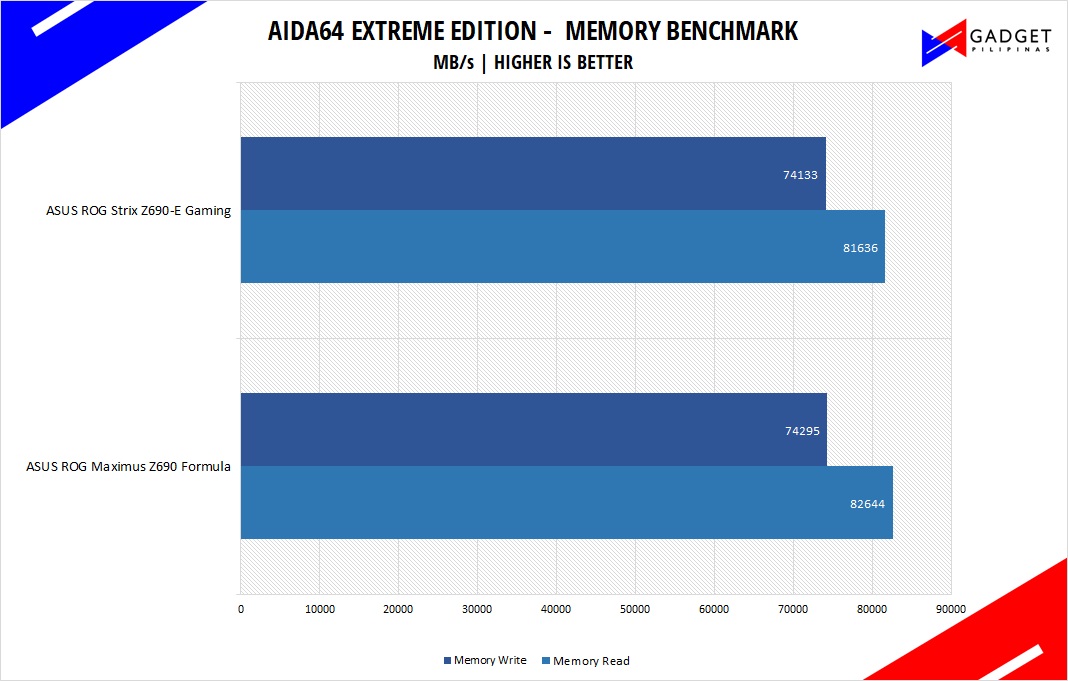 AIDA64 is a very popular and powerful monitoring tool, as well as a benchmarking application. AIDA64 is commonly used to stress test CPUs, especially testing if an overclock is stable. We used AIDA64’s Memory Benchmark to measure the data transfer bandwidth of the system memory.
AIDA64 is a very popular and powerful monitoring tool, as well as a benchmarking application. AIDA64 is commonly used to stress test CPUs, especially testing if an overclock is stable. We used AIDA64’s Memory Benchmark to measure the data transfer bandwidth of the system memory.
GeekBench 5.4.3
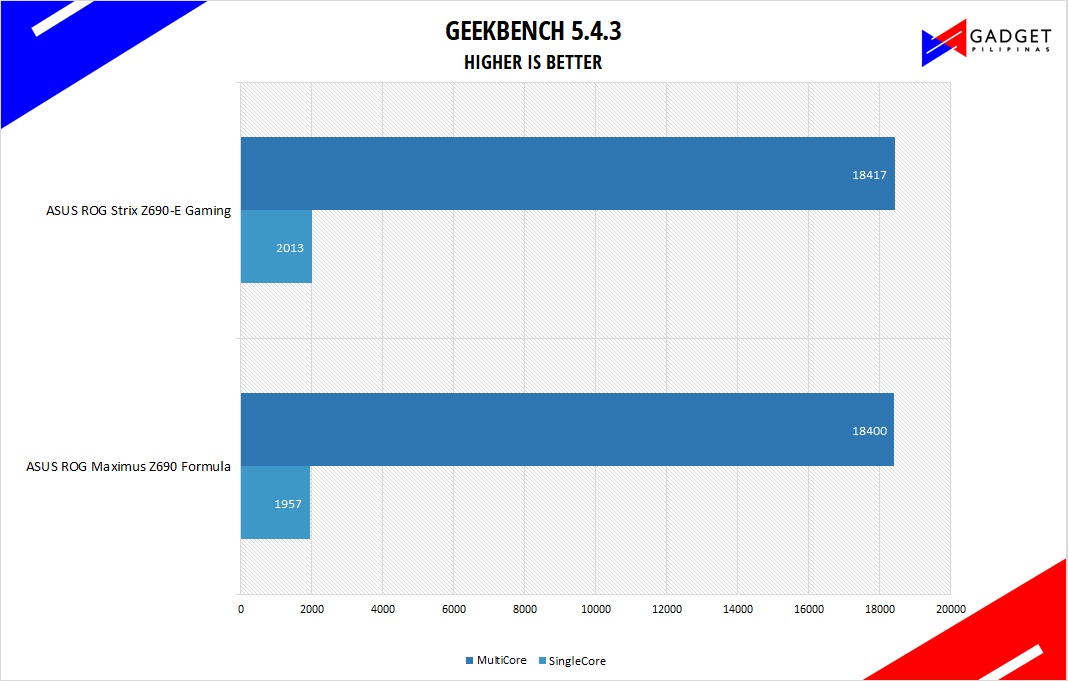 Geekbench is a multi-platform benchmark used to gauge CPU performance and compare them across Windows, Mac, and Mobile. Geekbench 5 is the latest version and doesn’t rely on memory than the previous Geekbench 4, making it a great tool to measure both single-core and multi-core CPU performance.
Geekbench is a multi-platform benchmark used to gauge CPU performance and compare them across Windows, Mac, and Mobile. Geekbench 5 is the latest version and doesn’t rely on memory than the previous Geekbench 4, making it a great tool to measure both single-core and multi-core CPU performance.
CINEBENCH R20 & R23
- ASUS ROG Maximus Z690 Formula Review Cinebench R23 Benchmark
- ASUS ROG Maximus Z690 Formula Review Cinebench R23 Benchmark
- ASUS ROG Maximus Z690 Formula Review Cinebench R20 Benchmark
- ASUS ROG Maximus Z690 Formula Review Cinebench R20 Benchmark
Maxon’s Cinebench benchmark is one of the most iconic benchmark applications used by reviewers and enthusiasts. The latest Cinebench R20 uses the latest rendering architectures, including Intel’s Embree ray tracing technology and other advanced features from AMD and Intel that allow users to render the same scene on the same hard. Cinebench R20 uses a larger and more complex testing scene than Cinebench R20 by about 8x computational power and requires 4x the memory.
GOOGLE OCTANE 2.0
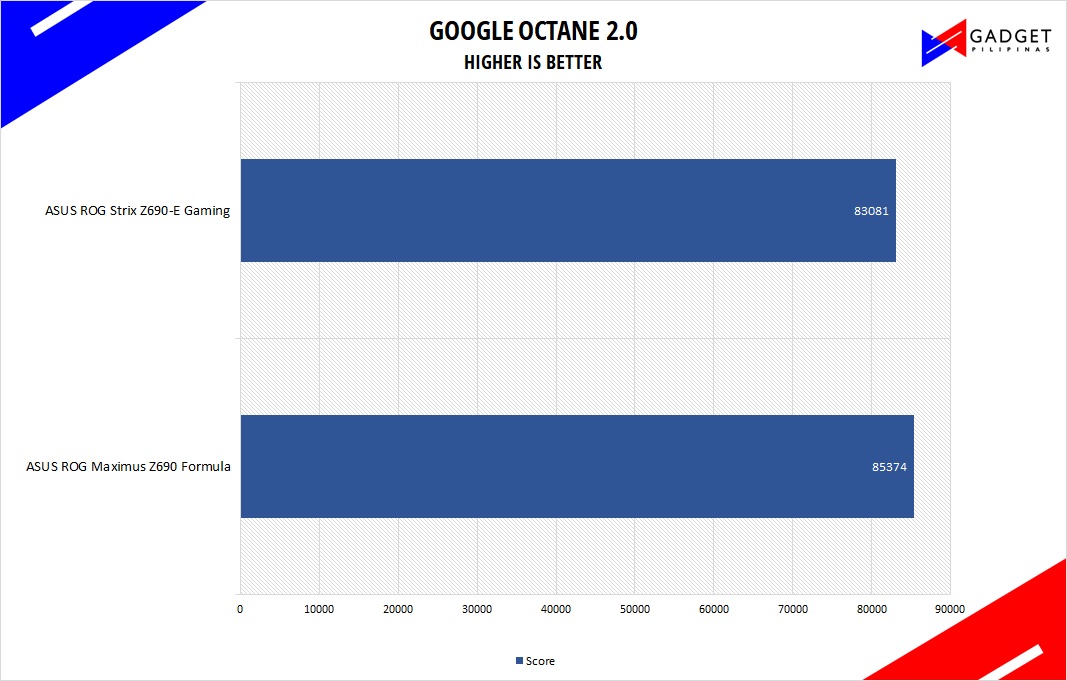 Google Octane 2.0 is a benchmark that measures a Javascript engine’s performance by running multiple tests representing different use cases of JavaScript applications. While Google Octane is retired and no longer maintained, it is still a good representation of today’s dynamic, interactive web applications. Our Google Octane 2.0 is run on Microsoft’s latest Chromium-based Edge browser.
Google Octane 2.0 is a benchmark that measures a Javascript engine’s performance by running multiple tests representing different use cases of JavaScript applications. While Google Octane is retired and no longer maintained, it is still a good representation of today’s dynamic, interactive web applications. Our Google Octane 2.0 is run on Microsoft’s latest Chromium-based Edge browser.
V-RAY 4.10 & 5
- ASUS ROG Maximus Z690 Formula Review Vray 4.1 Benchmark
- ASUS ROG Maximus Z690 Formula Review Vray 4.1 Benchmark
- ASUS ROG Maximus Z690 Formula Review Vray5 Benchmark
- ASUS ROG Maximus Z690 Formula Review Vray5 Benchmark
V-Ray Benchmark is a stand-alone version of V-Ray developed by Chaos Group. It is designed to test the CPU and GPU by rendering sample scenes at a fixed amount of time. V-Ray is a plug-in mostly utilized by 3D computer graphics software applications mainly for industrial design, product design, architecture, film, and video game production. V-Ray is not limited to 64-threads as it supports multi and mega-threading.
BLENDER
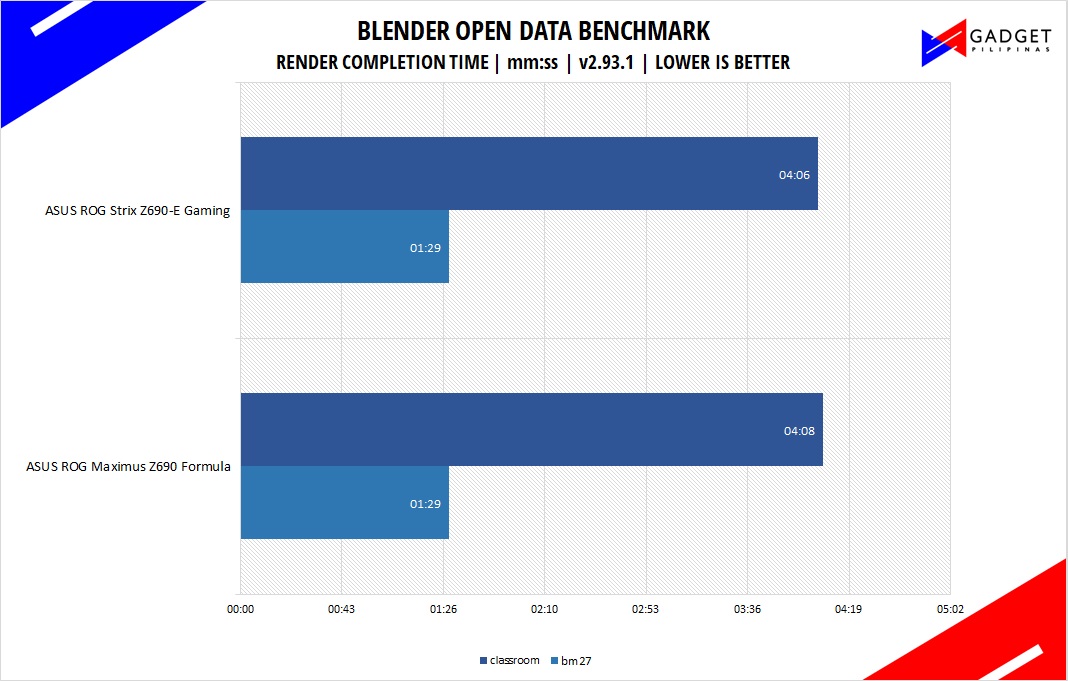 Blender is a widely used, free, open-source 3D creation suite. It supports the whole 3D pipeline process from modeling, rigging, animation, simulation, rendering, and even motion tracking. Blender has become a standard for CPU benchmarks with the BMW27 and Classroom scene most used. This prompted the company to release Blender Open Data Benchmark in 2018, a benchmark-specific version that allows users to run a preset benchmark and share the results online similar to 3D Mark.
Blender is a widely used, free, open-source 3D creation suite. It supports the whole 3D pipeline process from modeling, rigging, animation, simulation, rendering, and even motion tracking. Blender has become a standard for CPU benchmarks with the BMW27 and Classroom scene most used. This prompted the company to release Blender Open Data Benchmark in 2018, a benchmark-specific version that allows users to run a preset benchmark and share the results online similar to 3D Mark.
CORONA RENDERER
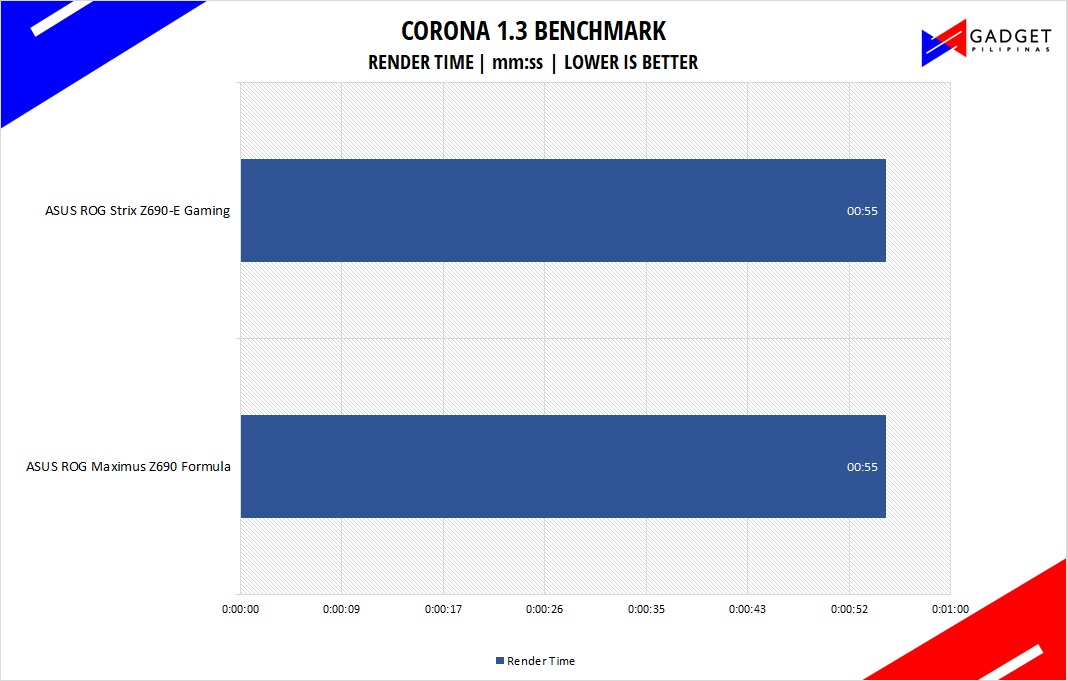 Corona Renderer is an unbiased photorealistic render available for Autodesk 3Ds Max, Maxon Cinema 4D, and as a stand-alone application. Its popularity, like Blender, led Chaos Group to develop a benchmark version of the app which runs using Corona Renderer 1.3. Workstation systems, especially CPUs, can utilize Corona Benchmark as up to 72 threads can be used in the benchmark, making it very suitable for CPUs with various price segments.
Corona Renderer is an unbiased photorealistic render available for Autodesk 3Ds Max, Maxon Cinema 4D, and as a stand-alone application. Its popularity, like Blender, led Chaos Group to develop a benchmark version of the app which runs using Corona Renderer 1.3. Workstation systems, especially CPUs, can utilize Corona Benchmark as up to 72 threads can be used in the benchmark, making it very suitable for CPUs with various price segments.
PCMark10
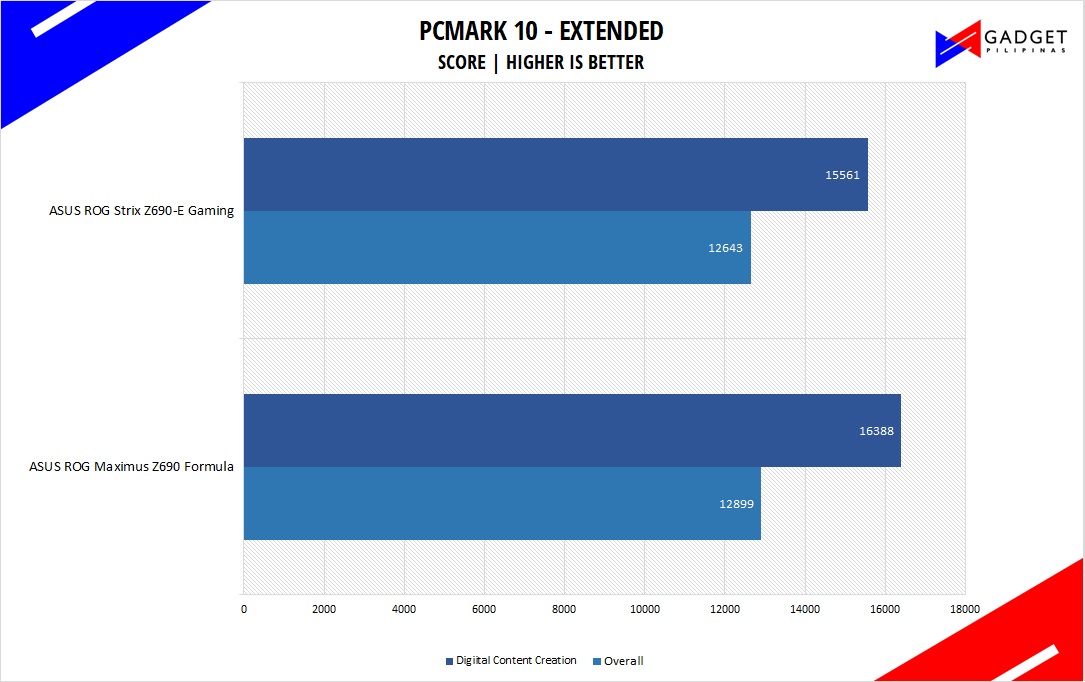 From the same developers of the popular game benchmarking tool 3DMark, PCMark 10 is a benchmarking app for measuring a whole PC’s performance. It covers a wide variety of tests to reflect common tasks performed in a modern workplace. We selected PCMark 10’s extended benchmark and reported both the overall score and Digital Content Creation Score.
From the same developers of the popular game benchmarking tool 3DMark, PCMark 10 is a benchmarking app for measuring a whole PC’s performance. It covers a wide variety of tests to reflect common tasks performed in a modern workplace. We selected PCMark 10’s extended benchmark and reported both the overall score and Digital Content Creation Score.
HANDBRAKE
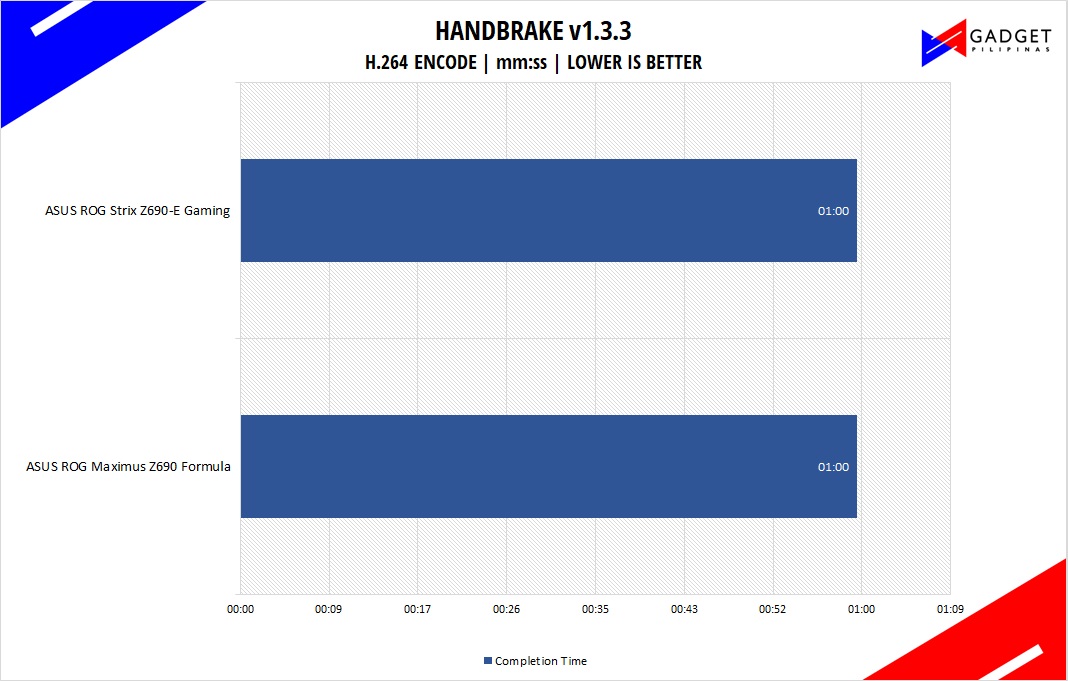 Handbrake is a top-rated open-source video conversion software that is used by professionals, enthusiasts, and even reviewers as a reference point mainly because of its wide variety of media codecs. The rise of streaming and blogging makes video content, both encoding, and transcoding important for these people, regardless of whether they’re seasoned professionals or just starting out. Handbrake also takes advantage of AVX-512 and OpenCL to accelerate certain types of media codecs. Our Handbrake benchmark converts a 500MB MP4 video to H.264 to measure the processor’s performance.
Handbrake is a top-rated open-source video conversion software that is used by professionals, enthusiasts, and even reviewers as a reference point mainly because of its wide variety of media codecs. The rise of streaming and blogging makes video content, both encoding, and transcoding important for these people, regardless of whether they’re seasoned professionals or just starting out. Handbrake also takes advantage of AVX-512 and OpenCL to accelerate certain types of media codecs. Our Handbrake benchmark converts a 500MB MP4 video to H.264 to measure the processor’s performance.
3DMARK
- ASUS ROG Maximus Z690 Formula Review 3DMark Firestrike Benchmark
- ASUS ROG Maximus Z690 Formula Review 3DMark Firestrike Benchmark
- ASUS ROG Maximus Z690 Formula Review 3DMark TimeSpy Benchmark
- ASUS ROG Maximus Z690 Formula Review 3DMark TimeSpy Benchmark
3DMark is the go-to benchmark for gamers because of the ability to share and compare results online. We tested the Intel Core i9 12900K both in Fire Strike and Time Spy to get a good gauge of DX 11 and DX 12 API performance.
ASUS ROG Maximus Z690 Formula UEFI BIOS
- ROG Maximus Z690 Formula Review BIOS 02
- ROG Maximus Z690 Formula Review BIOS 02
- ROG Maximus Z690 Formula Review BIOS 03
- ROG Maximus Z690 Formula Review BIOS 03
- ROG Maximus Z690 Formula Review BIOS 04
- ROG Maximus Z690 Formula Review BIOS 04
- ROG Maximus Z690 Formula Review BIOS 05
- ROG Maximus Z690 Formula Review BIOS 05
- ROG Maximus Z690 Formula Review BIOS 06
- ROG Maximus Z690 Formula Review BIOS 06
- ROG Maximus Z690 Formula Review BIOS 07
- ROG Maximus Z690 Formula Review BIOS 07
- ROG Maximus Z690 Formula Review BIOS 01
- ROG Maximus Z690 Formula Review BIOS 01
There are not many changes in ASUS ROG’s general UEFI BIOS with the exception to Alderlake specific BIOS settings. For our benchmark and review, we decided to run the motherboard at its out-of-the-box configuration with XMP enabled. The BIOS is updated to the latest version – BIOS 0803.
ASUS ROG Maximus Z690 Formula VRM Thermals
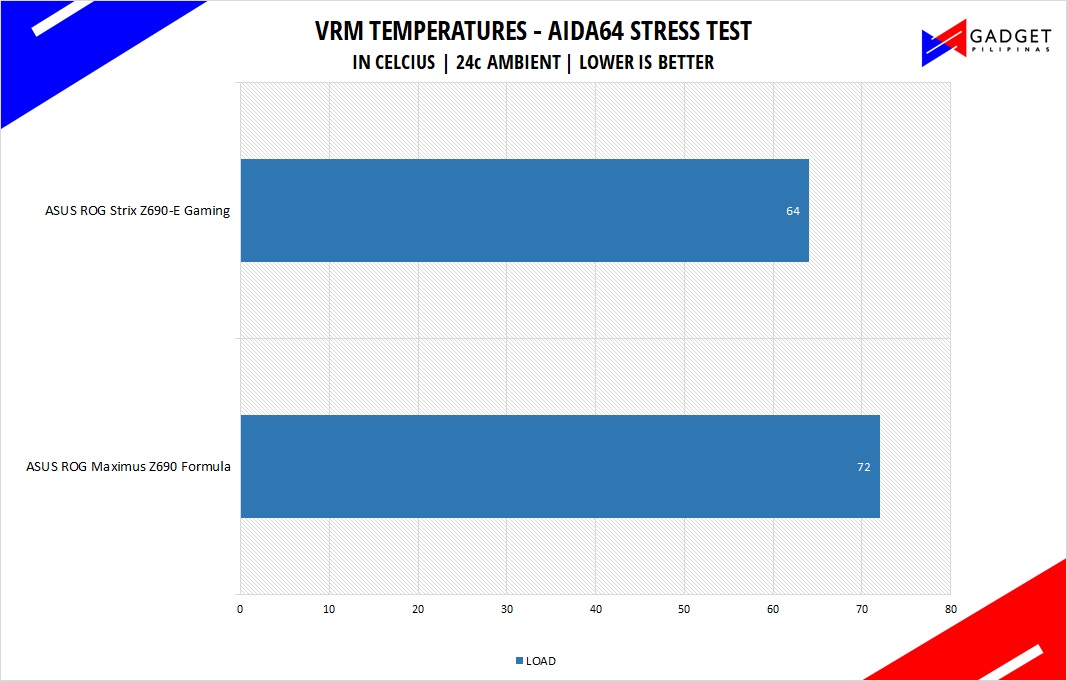
Our stress test consists of an Aida64 system stability test with a Cinebench R20 multi-core render loop running for one hour. We then measured the VRM temperatures as well using a K-type thermometer and a FLIR One Gen 3 thermal camera. The higher VRM temps on the Maximus Z690 Formula versus the ROG Strix Z690-E is expected as a portion of the Z690 Formula’s VRM heatsink surface area is a water block that does almost nothing in terms of cooling if you don’t hook it up to a custom loop. 72°C is still relatively cool as we’re running an Intel Core i9 12900K that consumes 240-watts on average.
- ROG Maximus Z690 Formula Review 004
- ROG Maximus Z690 Formula Review 004
- ROG Maximus Z690 Formula Review 005
- ROG Maximus Z690 Formula Review 005
Our FLIR Camera shows some hot spots around and on the VRM area with the hottest one on the bottom end of the VRM with a recorded temperature of 58.5°C. The VRM heatsink and water block combo are relatively cool at 40.4°C and will surely be cooler if you were to use a custom liquid cooling setup.
CONCLUSION
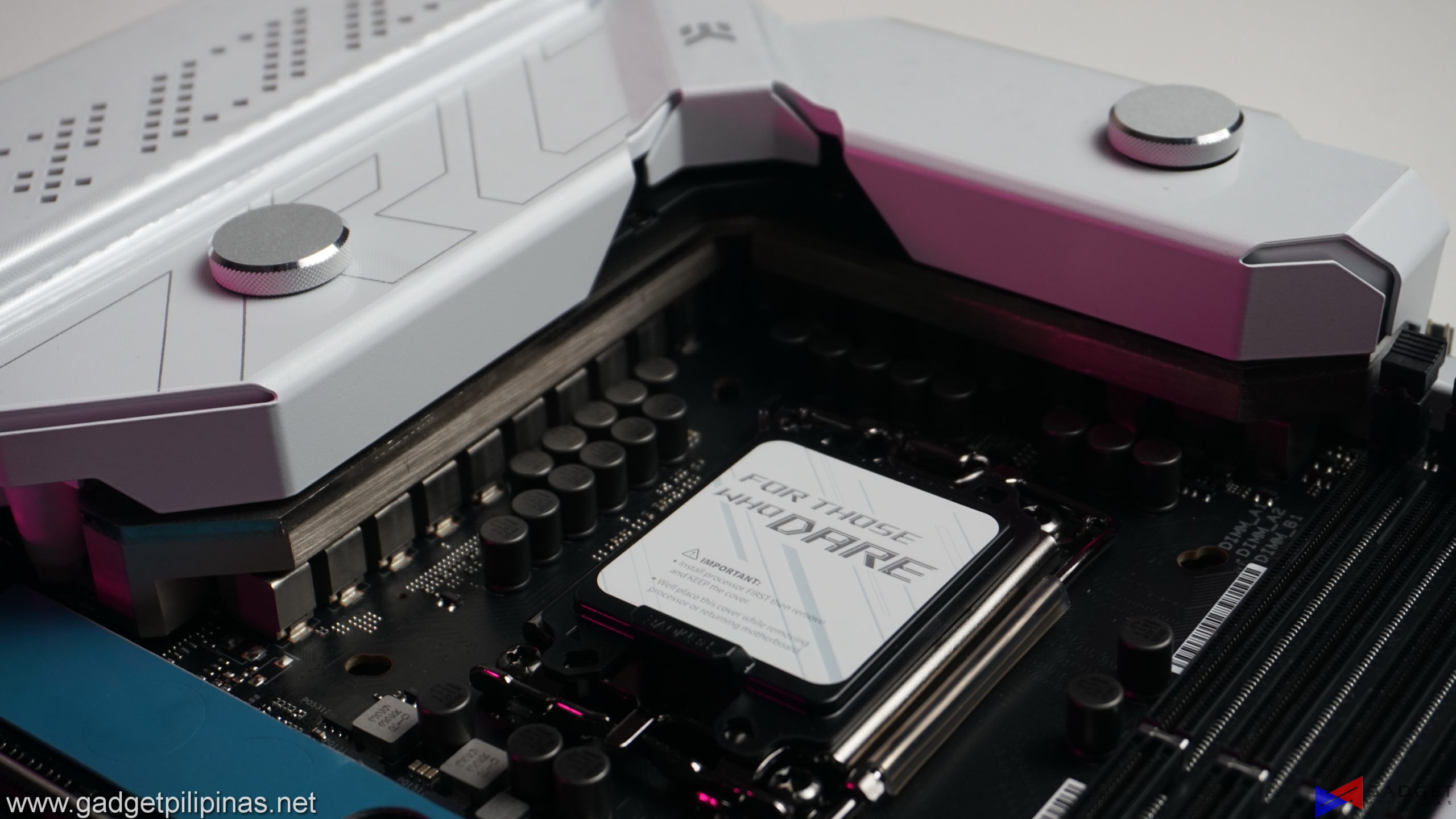
Our benchmarks confirm our early thoughts on our overview article as the ASUS ROG Maximus Z690 Formula makes a spectacular comeback with top-notch quality, jam-packed features, and enthusiast-level performance. The new Moonlight white look makes it more appealing and provides users a high-end option for a white-themed motherboard. Moreover, the new look veers away from the standard ROG dystopian cybertext design making the Z690 Formula a cross between Pro Art, Prime, and ROG Strix designs. Aside from the performance-related improvements with its 90A MOSFETS and liquid-cooling ready Crosschill VRM heatsink, the ASUS ROG Z690 Formula also brings in a wide range of quality of life improvements such as the implementation of Q-Latch, Q-Release, and LGA 1200 mounting holes. Bandwidth is also a strong suit of the ROG Z690 Formula thanks to WIFI 6E, PCI-E 5.0, two Thunderbolt 4 ports, 10Gb Ethernet, and five M.2 slots with a Hyper M.2 card. There’s really no lacking feature of the Z690 Formula with the far exception of another ethernet port found on higher-end Maximus Z690 motherboards but apart from that, the ROG Maximus Z690 Formula holds its value despite the hefty $825 US / Php 41,790 price tag that’s slightly more expensive than the Intel Core i9 12900K itself.
Overall, the ASUS ROG Maximus Z690 Formula strikes every premium feature that you could ask for as an enthusiast or overclocker without the unnecessary gimmicks and accessories to justify its large asking price. The comeback of the Formula model is a much-welcomed one with improvements made in all aspects from aesthetics, build quality, performance, connectivity, and user-friendliness. The ASUS ROG Maximus Z690 Formula should’ve been an easy recommendation for an enthusiast-level board if it weren’t for the price which in Asus’ credit is justified with the aforementioned improvements. If you happen to be looking for a board with robust connectivity and all of the latest features to make your PC and i9 12900K last for years, then the ROG Maximus Z690 Formula is a very solid investment be it for productivity and gaming.
Grant is a Financial Management graduate from UST. His passion for gadgets and tech crossed him over in the industry where he could apply his knowledge as an enthusiast and in-depth analytic skills as a Finance Major. His passion allows him to earn at the same time help Gadget Pilipinas' readers in making smart, value-based decisions and purchases with his reviews and guides.

